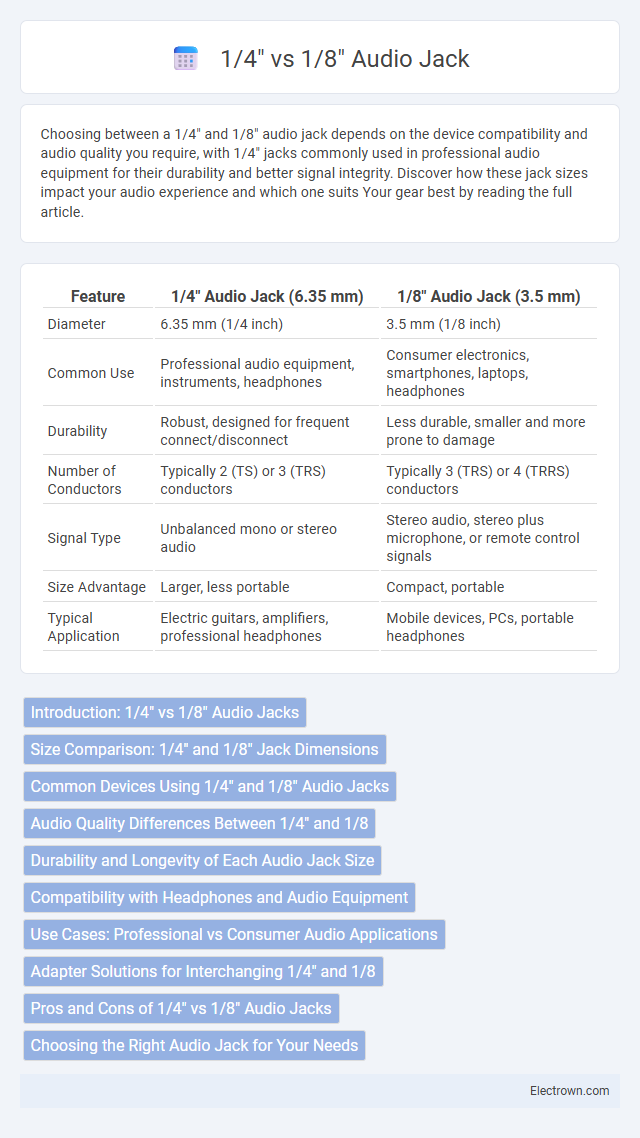Choosing between a 1/4" and 1/8" audio jack depends on the device compatibility and audio quality you require, with 1/4" jacks commonly used in professional audio equipment for their durability and better signal integrity. Discover how these jack sizes impact your audio experience and which one suits Your gear best by reading the full article.
Table of Comparison
| Feature | 1/4" Audio Jack (6.35 mm) | 1/8" Audio Jack (3.5 mm) |
|---|---|---|
| Diameter | 6.35 mm (1/4 inch) | 3.5 mm (1/8 inch) |
| Common Use | Professional audio equipment, instruments, headphones | Consumer electronics, smartphones, laptops, headphones |
| Durability | Robust, designed for frequent connect/disconnect | Less durable, smaller and more prone to damage |
| Number of Conductors | Typically 2 (TS) or 3 (TRS) conductors | Typically 3 (TRS) or 4 (TRRS) conductors |
| Signal Type | Unbalanced mono or stereo audio | Stereo audio, stereo plus microphone, or remote control signals |
| Size Advantage | Larger, less portable | Compact, portable |
| Typical Application | Electric guitars, amplifiers, professional headphones | Mobile devices, PCs, portable headphones |
Introduction: 1/4" vs 1/8" Audio Jacks
1/4" audio jacks, also known as 6.35mm jacks, are commonly used in professional audio equipment, offering robust connections for instruments and headphones with enhanced durability and signal quality. In contrast, 1/8" audio jacks, or 3.5mm jacks, are standard in consumer electronics like smartphones and laptops, providing compact and convenient connectivity for everyday use. The choice between 1/4" and 1/8" audio jacks depends on factors such as audio fidelity requirements, device compatibility, and intended application.
Size Comparison: 1/4" and 1/8" Jack Dimensions
The 1/4" audio jack measures 6.35mm in diameter, making it significantly larger than the 1/8" jack, which has a diameter of 3.5mm. This size difference impacts compatibility with various audio devices, with 1/4" jacks commonly used in professional audio equipment and 1/8" jacks favored for consumer headphones and portable devices. The larger 1/4" jack also allows for more robust connection and better durability in high-use environments.
Common Devices Using 1/4" and 1/8" Audio Jacks
The 1/4" audio jack is commonly found on professional audio equipment such as electric guitars, amplifiers, and studio headphones due to its robust build and secure connection. The 1/8" (3.5mm) audio jack is widely used in consumer electronics, including smartphones, laptops, and portable headphones, offering convenience and compatibility with smaller devices. When choosing audio gear, understanding that your professional instruments or studio monitors likely use 1/4" jacks, while everyday gadgets rely on 1/8" jacks, ensures the right connection for optimal sound quality.
Audio Quality Differences Between 1/4" and 1/8
The 1/4" audio jack typically delivers superior audio quality compared to the 1/8" jack due to its larger size, which allows for better connection stability and reduced signal interference. This results in clearer sound with less noise, making the 1/4" jack ideal for professional audio equipment and high-fidelity headphones. When choosing between the two, consider your audio setup, as your experience can significantly improve with the 1/4" connector's enhanced sound transmission capabilities.
Durability and Longevity of Each Audio Jack Size
1/4" audio jacks generally offer greater durability and longevity due to their larger size and sturdier metal construction, making them ideal for professional audio environments where frequent plugging and unplugging occur. The 1/8" audio jacks, being smaller and more delicate, are more prone to wear and damage over time, especially with heavy use and less robust materials. High-quality 1/8" jacks can still provide reasonable lifespan but typically do not match the mechanical resilience of 1/4" connectors.
Compatibility with Headphones and Audio Equipment
The 1/4" audio jack, commonly used in professional audio equipment like studio headphones and amplifiers, offers a secure connection and is compatible with high-end headphones requiring robust sound quality. The 1/8" audio jack, also known as the 3.5mm jack, is widely used in consumer electronics such as smartphones, laptops, and portable audio devices, ensuring broad compatibility with typical headphones. Choosing the right jack depends on Your device's input and the headphones' connector size for seamless audio performance.
Use Cases: Professional vs Consumer Audio Applications
The 1/4" audio jack is commonly used in professional audio applications such as studio monitors, electric guitars, and mixing consoles due to its durability and balanced signal transmission. The 1/8" audio jack is primarily designed for consumer electronics like headphones, smartphones, and portable media players, offering compact size and convenience for everyday use. Your choice between the two should depend on the requirement for sound quality, signal stability, and device compatibility in your audio setup.
Adapter Solutions for Interchanging 1/4" and 1/8
Adapters for interchanging 1/4" and 1/8" audio jacks enable seamless connectivity between professional audio equipment and consumer devices. Common solutions include 1/4" female to 1/8" male adapters and vice versa, ensuring compatibility without compromising signal quality. High-quality adapters often feature gold-plated contacts to reduce signal loss and maintain audio integrity during conversion.
Pros and Cons of 1/4" vs 1/8" Audio Jacks
The 1/4" audio jack offers superior durability and better signal quality, making it the preferred choice for professional audio equipment and instruments, but its larger size limits portability and compatibility with compact devices. Conversely, the 1/8" (3.5mm) audio jack excels in convenience and widespread use across smartphones, laptops, and portable devices, though it is more prone to damage and may provide less robust audio connections. Choosing between the two depends on balancing professional-grade audio fidelity and ruggedness against convenience and device compatibility.
Choosing the Right Audio Jack for Your Needs
Selecting between a 1/4" and 1/8" audio jack depends on device compatibility and audio quality requirements. The 1/4" jack, commonly used in professional audio equipment, offers robust durability and superior signal transmission, making it ideal for instruments and studio headphones. In contrast, the 1/8" jack, widely found in consumer electronics like smartphones and laptops, provides compact convenience but may sacrifice some audio fidelity compared to the larger counterpart.
1/4" vs 1/8" audio jack Infographic

 electrown.com
electrown.com